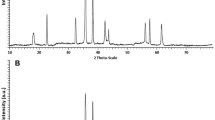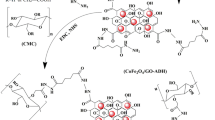Abstract
In this present manuscript, zinc oxide (ZnO) nanoparticles embedded carboxymethyl cellulose (CMC) bionanocomposite were prepared by in situ grafting and the hydrophobic anticancer drug curcumin (Cur) was loaded into it. Structural, morphological, and physiochemical behavior of prepared curcumin-loaded CMC/ZnO nanocomposites (NCs) were characterized by FTIR, XRD, SEM, TEM, TGA, and DTA. The drug entrapment efficiency was evaluated and the in vitro efficacy as anticancer drug delivery vehicle was analyzed. The potential toxicity of curcumin-loaded ZnO/CMC NCs (Cur/ZnO/CMC NCs) was studied by using L929 and MA104 cell lines via MTT assay. The cellular uptake study of Cur/ZnO/CMC NCs by normal (L929) and cancer (MA104) cells carried out by using ethanol extraction and by FACS analysis has been reported. The results of this investigation demonstrate that the nanomatrix synthesized can effectively deliver the anticancer drug curcumin, and hence appears to be a promising nanoformulation for anticancer therapy and other biomedical applications.







Similar content being viewed by others
References
Di Sia P (2012) THz spectroscopy and nanostructures: a short interesting review. Lett Appl Nanobiosci 1:8
Jude IN, Luke MG, John K, Clement LH (2013) Development of novel chitosan-poly(N, N-diethylacrylamide) IPN films for potential wound dressing and biomedical applications. J Polym Res 20:1
Ionela A, Gheorghe F, Mariana C, Valeria H, Marieta C (2013) Thermo- and pH-sensitive interpenetrating poly(N-isopropylacrylamide)/carboxymethyl pullulan network for drug delivery. J Polym Res 20:293
Xiu-Li W, Yan-Li Z, Dao-Lu T, Gui-Ying L, Yu-Zhong W (2012) Self-assembly, drug-delivery behavior, and cytotoxicity evaluation of amphiphilic chitosan-graft-poly(1,4-dioxan-2-one) copolymers. J Polym Res 19:1–9
Shi L, Tang C, Yin C (2012) Glycyrrhizin-modified-O-carboxymethyl chitosan nanoparticles as drug vehicles targeting hepatocellular carcinoma. Biomaterials 33:7594
Rejinold NS, Muthunarayanan M, Divyarani VV, Sreerekha PR, Chennazhi KP, Nair SV, Tamura H, Jayakumar R (2011) Curcumin loaded biocompatible thermoresponsive polymeric nanoparticles for cancer drug delivery. J Coll Interf Sci 360:39
Jiugao Y, Jingwen Y, Baoxiang L, Xiaofei M (2009) Preparation and characterization of glycerol plasticized-pea starch/ZnO–carboxymethylcellulose sodium nanocomposites. Bioresour Technol 100:2832–41
Bayarri S, Gonzalez-Tomas L, Costell L (2009) Viscoelastic properties of aqueous and milk systems with carboxymethyl cellulose. Food Hydrocoll 23:441
Biswal DR, Singh RP (2004) Characterisation of carboxymethyl cellulose and polyacrylamide graft copolymer. Carbohydr Polym 57:379
Pushpamalar V, Langford SJ, Ahmad M, Lim YY (2006) Optimization of reaction conditions for preparing carboxymethyl cellulose from sago waste. Carbohydr Polym 64:312–8
Ueno T, Yokota S, Kitaoka T, Wariishi H (2007) Conformational changes in single carboxymethyl-cellulose chains on a highly oriented pyrolytic graphite surface under different salt conditions. Carbohydr Res 342:954–60
Kuttan R, Bhanumathy P, Nirmala K, George MC (1985) Potential anticancer activity of turmeric (Curcuma longa). Cancer Lett 29:197
Jordan WC, Drew CR (1996) Curcumin––a natural herb with anti- HIV activity. J Natl Med Assoc 88:33
Srimal RC, Dhawan BN (1973) Pharmacology of diferuloyl methane (curcumin), a non-steroidal anti-inflammatory agent. J Pharm Pharmacol 25:447
Sharma OP (1976) Antioxidant activity of curcumin and related compounds. Biochem Pharmacol 25:1811
Kim MK, Choi GJ, Lee HS (2003) Fungicidal property of Curcuma longa L. rhizome-derived curcumin against phytopathogenic fungi in a greenhouse. J Agric Food Chem 51:1578
Tonnesen HH (2002) Solubility, chemical and photochemical stability of curcumin in surfactant solutions. Studies of curcumin and curcuminoids. Pharmazie 57:820
Yallapu MM, Jaggi M, Chauhan SC (2012) Curcumin nanoformulations: a future nanomedicine for cancer. Drug Discov Today 17:71
Muqbil I, Masood A, Sarkar FH, Mohammad RM, Azmi AS: Progress in nanotechnology based approaches to enhance the potential of chemopreventive agents Cancers 3:428 (2011)
Yallapu MM, Jaggi M, Chauhan SC (2010) Poly(beta-cyclodextrin)/curcumin self-assembly: A novel approach to improve curcumin delivery and its therapeutic efficacy in prostate cancer cells. Macromol Biosci 10:1141
Yallapu MM, Othman SF, Curtis ET, Gupta BK, Jaggi M, Chauhan SC (2011) Multi-functional magnetic nanoparticles for magnetic resonance imaging and cancer therapy. Biomaterials 32:1890
Chandramouleeswaran S, TMhaske S, Kathe AA, Varadarajan PV, Prasad V, Vigneshwaran N (2007) Functional behaviour of polypropylene/ZnO–soluble starch nanocomposites. Nanotechnology 18:385702
Zhou J, Xu N, Wang ZL (2006) Dissolving behavior and stability of Zno wires in biofluids: A study on biodegradability and biocompatibility. Adv Mater 18:2432
Nie L, Gao L, Feng P, Zhang J, Fu X, Liu Y, Yan X, Wang T (2006) Three-dimensional functionalized tetrapod-like ZnO nanostructures for plasmid DNA delivery. Small 2:621
Zhang LL, Jiang YH, Ding YL (2010) Mechanistic investigation into antibacterial behaviour of suspensions of ZnO nanoparticles against E. coli. J Nanopart Res 12:1625
Huang ZB, Zheng X, Yan DH (2008) Toxicological effect of ZnO nanoparticles based on bacteria. Langmuir 24:4140
Hanley C, Layne J, Punnoose A (2008) Preferential killing of cancer cells and activated human T cells using ZnO nanoparticles. Nanotechnology 19:295103
Wang H, Wingett D, Engelhard MH (2009) Fluorescent dye encapsulated ZnO particles with cell- specific toxicity for potential use in biomedical applications. J Mater Sci Mater Med 20:11
Rasmussen JW, Martinez E, Louka P, Wingett DG (2010) Zinc oxide nanoparticles for selective destruction of tumor cells and potential for drug delivery applications. Expert Opin Drug Deliv 7:1063
Kim DG, Jeong YI, Choi C, Roh SH, Kang SK, Jang MK (2006) Retinol-encapsulated low molecular water-soluble chitosan nanoparticles. Int J Pharmaceut 319:130
Das RK, Kasoju N, Bora U (2010) Encapsulation of curcumin in alginate-chitosan-pluronic composite nanoparticles for delivery to cancer cells Nanomed. Nanotechnol Biol Med 6:153
Bisht S, Feldmann G, Soni S, Ravi R, Karikar C, Maitra M (2007) Polymeric nanoparticle-encapsulated curcumin (“nanocurcumin”): A novel strategy for human cancer therapy. J Nanobiotechnol 5:3
Su JF, Huang Z, Yuan XY, Wang XY, Li M: Structure and properties of carboxymethyl cellulose/soy protein isolate blend edible films crosslinked by Maillard reactions Carbohydr Polym 79: 145–53 (2010)
Yallapua MM, Jaggi M, Chauhana SC: Cyclodextrin-curcumin selfassembly enhances curcumin delivery in prostate cancer cells Colloids Surfaces B 79:113 (2010)
Chen C, Yu B, Liu P, Liu JF, Wang L (2011) Investigation of nano-sized ZnO particles fabricated by various synthesis routes. J Ceramic Processing Res 12:420
Acknowledgments
We thank Prof. P. Chakrabarti, Director, Motilal Nehru National Institute of Technology, Allahabad, India for providing other necessary facilities for research work. The author LU kindly acknowledges the Ministry of Human Resource Development (MHRD), Govt. of India for providing senior research fellowship (SRF) for research. JS kindly acknowledges Department of Science and Technology, New Delhi, India for awarding the INSPIRE FACULTY AWARD [IFA-13-CH-105].
Author information
Authors and Affiliations
Corresponding author
Rights and permissions
About this article
Cite this article
Upadhyaya, L., Singh, J., Agarwal, V. et al. In situ grafted nanostructured ZnO/carboxymethyl cellulose nanocomposites for efficient delivery of curcumin to cancer. J Polym Res 21, 550 (2014). https://doi.org/10.1007/s10965-014-0550-0
Received:
Accepted:
Published:
DOI: https://doi.org/10.1007/s10965-014-0550-0




